Abstract
One of the most important concerns in the planning and operation of an electric power generation system is the effective scheduling of all power generation facilities to meet growing power demand. Economic load dispatch (ELD) is a phenomenon where an optimal combination of power generating units is selected in such a way as to minimize the total fuel cost while satisfying the load demand, subject to operational constraints. Different numerical and metaheuristic optimization techniques have gained prominent importance and are widely used to solve the nonlinear problem. Although metaheuristic techniques have a good convergence rate than numerical techniques, however, their implementation seems difficult in the presence of nonlinear and dynamic parameters. This work is devoted to solving the ELD problem with the integration of variable energy resources using a modified directional bat algorithm (dBA). Then the proposed technique is validated via different realistic test cases consisting of thermal and renewable energy sources (RESs). From simulation results, it is observed that dBA reduces the operational cost with less computational time and has better convergence characteristics than that of standard BA and other popular techniques like particle swarm optimization (PSO) and genetic algorithm (GA).
1. Introduction
In a power system’s operation and control, the cost of electric power generation is a major concern due to increased demand in residential and commercial sectors. Due to interconnection among distributed electrical networks, the reduction of electric energy charges is of utmost importance. Even a minor decrease in electric energy cost creates a huge impact on the economics of the overall power system. Economic load dispatch (ELD), a subset of the unit commitment problem, is considered an extremely significant problem that deals with the minimization of a power generation facilities’ operational cost, where the primary job of power system engineers is to consider the economics of power systems. Moreover, the importance of this problem has greatly increased as it creates an impact on the environment. Economic dispatch also helps to minimize environmental pollutants to minimize fuel consumption. Furthermore, to improve the security of an electric system, there is also an utmost necessity to improve an ELD problem in terms of constraint to prevent any mishap like power system collapse.
The economics of any electric power system plays a significant role in encouraging researchers to find a technique that can reduce power generation cost up to a significant level. Traditionally, numerical techniques like gradient and Lambda iteration methods have been utilized to solve the ELD problem. However, due to the penetration of renewable energy resources, the optimization problem can add more complexity to nonlinear control variables. On the other hand, metaheuristic techniques are considered highly capable of solving high-dimensional ELD problems with less computational time. For example, in [1], a novel technique called the modified teaching-learning algorithm (MTLA) is presented. To overcome the convergence of the local optimum solution, a new stochastic self-adaptive mutation operator is introduced. Load forecast errors and contingencies of generating units are ignored in this research. In [2], modified particle swarm optimization (MPSO) is used to solve the ELD problem involving complex and non-continuous cost functions. This MPSO can deal with all types of constraints effectively. Furthermore, to speed-up the optimization process, a search space reduction strategy is proposed. In [3], an effort to find the optimum power combination of units at a minimum cost and under different power demands is performed using the augmented Lagrangian particle swarm optimization (ALPSO) technique. In [4], an improved PSO is used to solve the ELD problem, where a linearly decreasing inertia weight is combined with chaotic sequences to reduce the chances of premature convergence. However, this work does not consider strategies to reduce computational time for the high-dimensional ELD problem. In [5], authors proposed a mechanism to solve the ELD problem considering various practical constraints such as valve point loading (VPL) effects, ramp rate limits, prohibited operating zones (POZ), and multiple generator fuel options using the firefly algorithm and its variant, i.e., chaos mutation firefly algorithm (CMFA). The ability of the firefly algorithm is further enhanced by replacing the control parameters with fixed values. It is then achieved by self-adaption parameters, which affect solution quality, convergence speed, and reliability.
Similarly, in [6], a cuckoo search algorithm (CSA) is proposed for solving the nonconvex ELD problem by considering its various practical constraints. In [7], an enhanced bee swarm optimization method is utilized to solve a dynamic ELD problem, while maintaining a balance between exploration and exploitation. In [8], self-adaptive differential evolution and real coded genetic algorithm (GA) are proposed to solve the ELD problem. In [9], the dispatching of power is optimized using the firefly algorithm while avoiding the subjective penalty factors. In [10], a modified cuckoo search algorithm is proposed to solve the ELD problem considering VPL effects, POZ, losses, and ramp rate limits. This modification consists of self-adaptive step size and some neighbor study strategies to improve the performance of the standard cuckoo algorithm. With a high-dimensional test system, the efficiency of the proposed algorithm is tested. In [11], a modified version of PSO is presented for the ELD problem by considering different constraints. This makes the algorithm capable of search around feasible solution areas. In [12], more practical generator constraints like ramp rate limits and POZ are considered for the ELD problem. In [13], a quantum-inspired PSO is proposed to solve the ELD problem. By introducing quantum computing theory in the basic PSO, the searchability and convergence speed increases. In [14], an artificial immune system, evolutionary programming, and PSO are used for solving the ELD problem. In [15], novel PSO is applied to the ELD problem by considering the generator constraints. In the standard PSO, some mutation operators are introduced to improve its exploration capabilities. Mutation operators take charge as soon as the PSO velocity closes to zero or if it breaks lower and upper boundaries. PSO with mutation operators claims to outperform PSO easily. In [16], a detailed survey of PSO and its certain modifications is explained, while [17] deals with the hybridization of PSO with other algorithms to solve the ELD problem. In [18], ELD and combined economic and emission dispatch (CEED) problem is solved using an interior search algorithm (ISA). All the above-mentioned references are, however, used to solve all-thermal ELD problems that do not involve renewables.
However, a bat algorithm has also been found to solve all-thermal ELD problems successfully. In [19], the ELD problem is solved using a bat algorithm. The bat algorithm has proven to be better than PSO and the intelligent water drop (IWD) technique. The problem, however, does not include multiple fuels and spinning reserve cases. In [20], two different cost functions are considered, i.e., smooth and non-smooth. A bio-inspired bat optimization problem (BOA) is used for the optimum setting of control variables. In [21], the ELD problem with a quadratic fuel function is solved using BA. It was proved that BA is capable of solving complex constraints problems with ease as it is easy to operate. In addition, the minimization of emission released was also completed. In [22], a BAT algorithm is utilized to solve the ELD problem. A mathematical model is presented for the ELD problem. In [23], some previous algorithms like GA, PSO, and BA are reviewed. The original BA is modified to enhance its capabilities. In [24], a multi-objective self-adaptive BA is introduced to solve a practical environmental and emission dispatch problem considering valve point effects, transmission losses, and ramp rate limits. BA is utilized to achieve Pareto optimal solutions. Novel self-adaptive learning is added to improve the diversity of the population. In [25], a chaotic bat algorithm (CBA), a variant of the bat algorithm, is used to solve the ELD problem. This variant is obtained by incorporating chaotic sequences in the original bat algorithm to improve its performance. This less tuning algorithm claimed to perform better than many algorithms. In [26], an enhanced BA is utilized to solve the ELD problem by considering different generator constraints. In [27], many of the variants of BA are reviewed and some new variants are introduced for enhancing the exploration and exploitation capability of this algorithm. In [28], the novel bat algorithm (NBA) is utilized to solve the ELD problem. In this variant of the bat algorithm, the doppler effect is introduced. Results claimed that NBA has much better efficiency and robustness than BA and PSO.
At present, renewables-incorporated ELD problems are gaining much more attention to cope with the challenge of an energy shortage and the environment and are being solved using metaheuristic techniques. In [29], a hybrid metaheuristic algorithm RCBA is presented to solve the ELD problem by incorporating thermal generators and renewables like wind power. This algorithm combines a chaotic map and random black hole model to avoid premature convergence and move towards the global area. In [30], the reliability of generators and uncertainty of wind power generation is dealt with. For considering extreme conditions with probability, forecasting error relating to wind power generation is modeled as a discretized beta probability distribution function (PDF). In [31], a solution of optimum power dispatch in an interconnected microgrid is presented. A probabilistic model is used for a balanced sharing of power at a minimum operating cost. PSO and imperialist competitive algorithm (ICA) are used for the optimization of the objective function. Results deduced claimed that optimal sharing between the main grid and microgrid decreases the distribution networks’ cost. In [32], combined emission economic dispatch (CEED) is applied to a system consisting of thermal units and photovoltaic (PV) plants. The model considered is a mixed-integer optimization problem (MIOP) solved using PSO. In [33], ELD is solved using a dynamic adaptive bacterial foraging algorithm (BFA) with wind power incorporated. It was shown that this variant of BFA mitigates some drawbacks in the original BFA, such as poor convergence characteristics for high dimensional complex problems. In [34], a dynamic economic dispatch (DED) for the integration of large-scale renewable energy sources (RESs) with the ELD problem is reduced into dual stages using Lagrange relaxation where the multiplier is updated based on the quasi-Newton method. In [35], ELD considering wind power with forecast error is analyzed. As the wind uncertainty has a huge impact on power dispatch and a risk to the power grid, these forecast errors need to be minimized. In [36], the economic environmental dispatch problem is applied to a hybrid power system consisting of solar and wind energies. The strength Pareto evolutionary algorithm (SPEA) method is employed to solve this problem. In [37], the ELD problem considering RESs is solved using GA. It is shown that the inclusion of RESs impacts the economics of the system. However, this technique is not applied to the high-dimensional test case. In [38], the effect of substantial wind-based capacity on the economic load dispatch problem is considered. In [39], the ELD problem is considered with RESs. To deal with the uncertainty of wind and solar, their stochastic nature is modeled by Weibull and Beta distributions. An improved Fireworks algorithm is used to solve this highly-constrained problem. In [40], Lagrangian relaxation with the incremental proximal method is used to solve the ELD problem. In [41], combined emission economic dispatch (CEED) is solved using the lighting flash algorithm by considering different cases with wind power penetration, multiple fuel options, and generator constraints. In [42], a cost-effective hybrid microgrid system is designed with renewable sources like wind, hydrogen-based storage systems, and fuel cells. This optimal power problem is solved using PSO and is further compared with GA. In [43], the ELD problem by a microgrid containing solar and wind farms is solved using the reduced gradient method. It is shown that solar energy should be incorporated with renewable energy credits. In [44], a control system is presented that is capable of maintaining constant voltage magnitude at the wind farm terminal. The ELD problem is applied to a system containing thermal and wind power units. In [45], the ELD problem is solved using the BAT algorithm by including wind power. In the overall objective function, the stochastic nature of wind power is taken into account. Furthermore, due to the forecasting errors, imbalance charges (overestimation, underestimation) are also considered.
Unlike other methods, the directional bat algorithm (dBA) evolved as a promising variant of BA is limitedly used to solve renewables-incorporated ELD problems that have recently received considerable scholarly attention. The dBA introduces the directional echolocation to the structure of BA, which may get trapped locally for the complex and constrained dispatch problems, so as to enhance exploitation and exploration characteristics. To validate the superiority of dBA, in this paper, the ELD problem with and without renewables considering different test cases is solved using BA and dBA. With the help of compelling results, it was proved that dBA converges faster with minimized fitness value, thus justifying the claim that it is more effective than BA and other well-known GA and PSO techniques.
The paper commences with the formulation of an ELD problem considering combined thermal and RESs in Section 2. Steps involved in the standard BA with advantages, disadvantages, and a few variants are highlighted in Section 3. Section 3 also introduces dBA and discusses the steps involved in implementing this technique. Section 4 shows the simulation results of the test cases with specific characteristics of particular cases. Finally, the findings of the paper are pointed out in Section 5.
2. Problem Formulation
The objective of this research is to minimize the operating cost of a thermal unit system by integrating solar PV and wind energy units, subject to power demand and dispatch limitations.
2.1. Thermal Energy
The cost function of a thermal power plant without and with the valve point effect (VPL) is a second-order polynomial function:
where a, b, c, e, and f are fuel cost coefficients of power generation unit i whereas the total cost of j thermal units is expressed by .
2.2. Wind Energy
The power generated by wind turbines can be written as:
where is the air density, is wind speed, and A is the windswept area, respectively. The cost function of wind generation is subject to the investment cost of the equipment and the operation and maintenance (O&M) cost of generated energy. However, the capital cost of land, assuming it is a community-based microgrid where the land is owned by the community [43] is given as:
where a can be expressed as:
where is the wind generation in (kW), is an annuitization coefficient (dimensionless), is the interest rate (taken as 0.09 for base case), is the investment lifetime (N = 20 years), is the investment cost per unit installed power ($/kW), and GE is the O&M cost per unit of generated energy ($/kW), respectively. In this system, it is assumed that and are approximately equal to $1400 and 1.6 cents per kW, respectively.
2.3. Solar PV Energy
The maximum power provided by a solar panel is given by [43]:
where is the output power, is the capacity of each PV panel, is the temperature, and is the radiation data at time i, respectively. The cost function of solar generation in [43] involves the investment cost of the equipment and the O&M cost of the generated energy. However, without the capital cost of land, it can be expressed as:
where a is written as:
where is the solar generation (kW), is an annuitization coefficient (dimensionless), is the interest rate (taken as 0.09 for base case), is the investment lifetime (taken as N = 20 years), is the investment costs per unit installed power ($/kW), and GE is the O&M cost per unit generated energy ($/kW), respectively). In this system, it is assumed that the investment costs per unit installed power (Ip) and O&M cost per unit generated energy (GE) are approximately equal to $5000 and 1.6 cents per kW, respectively.
In the case of RESs, the generating cost parameter is not taken into account. The RESs that are considered in this research are wind energy and solar PV energy, whose forecasting is taken from [43] and is shown in Figure 1. A comprehensive review of the forecasting approaches for wind and solar power generation can be found in [46].
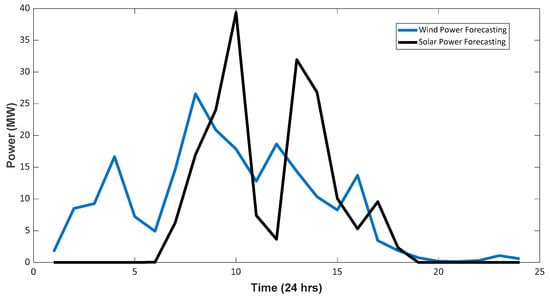
Figure 1.
Wind and solar power forecasting.
2.4. Overall Cost Function Incorporating Renewables
Adding all the cost functions described in (1), (3), and (6) gives the overall cost function as:
The following constraints (equalities and inequalities) have been considered while minimizing the overall cost function.
Power Balance Equation: Neglecting the transmission losses, the total generated power of all the units (thermals and renewables) should be equal to the total system demand , i.e.,
Generator Capacity Limits: The power delivered by each generating unit should remain within its minimum and maximum limits.
where and signify the ith generating unit’s minimum and maximum output power, respectively.
3. A Variant of BA for the ELD Problem
3.1. Overview of BA
This algorithm is inspired by microbats. The rules followed by this algorithm emerge from the certain behavior of bats, which are discussed as follows [47]:
- Bats use echolocation to sense distance and to know the difference between food and prey. In our case, the fitness function is food and bats, which are the possible solutions;
- The bats fly randomly with some predefined velocity vi at a position xi with a predefined frequency fi. They can adjust their frequency of pulse emitted;
- They can vary the rate of pulses by looking at the target proximity;
- Loudness can be varied from a large positive value to a small value.
Figure 2 shows the flowchart involved in the process. The algorithm progresses by taking the following steps:
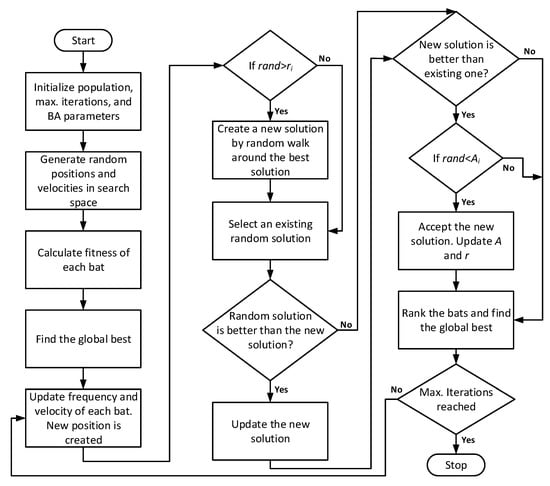
Figure 2.
Flow chart of the bat algorithm (BA).
- Firstly, we initialize the algorithm with maximum iterations, bat population, loudness constant α, pulse rate constants γ, initial values of loudness, and pulse rates;
- Give a random position to all bats in the solution space within the lower and upper boundary;
- Find the best bat position x* and its fitness;
- Start the process in which the position is updated one by one by:where is the velocity of bat i at a certain position at iteration t. There is the global best position x* among all the bats. Minimum and maximum frequency is selected depending on the application. The value will be between 0 and 1.
- Now a random number is generated (between 0 and 1) and is compared with pulse rate. Based on pulse rate, local search is done around the best solution by:
- An existing random solution k is selected with k ≠ i and is compared with the new solution. If it is better, then update the new solution by:
- The new solution from the previous step will be compared with the existing positions of the current bat. Furthermore, a random number will again be generated and compared with loudness of that bat. If the new solution of the previous step is better than the global best solution, and the random number is less than loudness, then a new solution will be accepted, and the loudness and pulse rate of that bat will be updated based on the following expressions:
Loudness and pulse rates play a vital role in finding the best result in terms of control exploration and exploitation. The value of loudness will decrease from a positive value to a certain minimum value, while the pulse rate will increase from a small value to a large value as the bat finds its prey. and are the constants of loudness and pulse rate, and the value of will be any value between 0 and 1 and is greater than 0. Optimum values of and have been selected as 0.9 and 0.98, respectively [47].
Although the bat algorithm comes with the advantages of having a highly efficient, reliable, easy structure and can be programmed from any programming language easily, it suffers from limitations of premature convergence, which increases with complexity and bat moves by the information from the best bat (best bat could be local optimum). This requires a modification in the structure of the BA to handle the nonconvex ELD problem. Much research has been done to improve the exploration and exploitation capabilities of the BA. There are many variants of the BA [27]. Some of the variants, such as the novel BA [28], enhanced BA [26], chaotic BA [25], and modified BA [23] have already been applied to solve the ELD problem. In this paper, we are going to apply a dBA to tackle the renewables-incorporated ELD problem.
3.2. dBA
dBA plays a dual role at different stages of the algorithm. In the beginning, it helps to explore more search space and as the process moves, the bats move around the leader, which improves the exploitation ability. It has a strong exploitation process that increases the convergence speed without being trapped in local optima. By adding a scale factor in the local search step, bats are allowed to move randomly with large steps. This results in enhancing the exploration capability of the algorithm. A decrease in the scale factor as the iteration proceeds improves the exploitation capability [48,49].
The procedure followed by dBA is very similar to the original BA; however, some modifications are made to improve its diversification and intensification [48,49]. Figure 3 shows the flow chart involved in the dBA process.
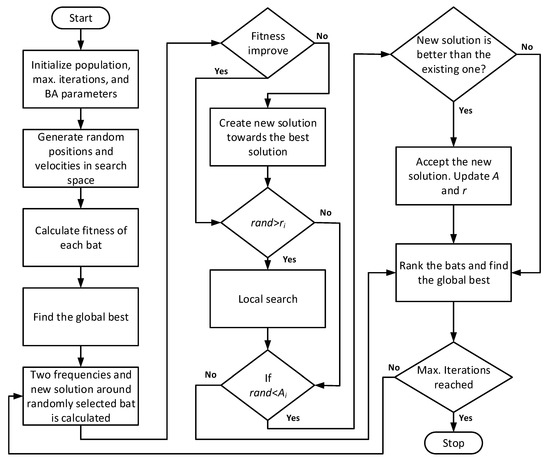
Figure 3.
Flow chart of the directional bat algorithm (dBA).
- Firstly, bats are initialized by giving random positions within the upper and lower boundaries of each bat;
- The standard BA has two navigation modes: First, towards the best solution and second, to exploit the best solution. In directional echolocation, bats move by analyzing their echoes. In addition, a bat takes help from other bats for better decisions. One of the bat pulses is toward the leader and another one toward a randomly selected bat. If the food exists around that random bat, the bat moves toward it otherwise, it moves toward the leader (best bat). Equations (13) and (14) depict this movement as follows:If the food does not exist around the random bat, then a bat will move towards the leader:where shows the position of randomly selected bat k where k ≠ i and shows the position of the global best. In the above equations, f1 and f2 are the frequencies of two pulses which are assigned as:where rand1 and rand2 are random numbers between 0 and 1;
- In the next step, the local search step is done similar to BA. However, the equation is modified by including a scale factor as follows:where is the average loudness and ε has a random value between −1 and 1. The value of starts from a large value and then reduces to 1% of a quarter of its length as follows:where and show the initial and final values, respectively, and t and tmax show the current and maximum iteration, respectively. The value of and can be set as:Here and show the upper and lower bounds, respectively;
- In the next step, which is similar to the standard BA, a random number is compared with loudness, but unlike the standard BA, a new solution is compared with the existing solution of that bat (not the global best). This step helps to improve the diversity of the algorithm. If these two conditions are true, then only new solutions are accepted. The pulse rate has an important role as it decides a balance between exploration and exploitation. Moreover, the loudness and pulse rate are updated as follows:where A and r show the loudness and pulse rate, respectively. For the best results, the optimum values recommended in the literature are 0.1 and 0.7 for pulse rate, and 0.9 and 0.6 for loudness;
- In the last step, the new solution is compared with the global solution. If it has better fitness, then the global solution is updated [48,49].
4. Simulation Results and Discussion
To validate the successful application of dBA to the ELD problem and to show its superiority over GA, PSO, and BA, two test systems, namely an IEEE 57-bus system with 7 thermal units driving from fossil fuels and a high dimensional 15-unit system, with and without renewables, are considered. A MATLAB environment was used to solve the test systems. Unless otherwise specified, for all the simulation results, the population and iteration were selected at 100 and 1000, respectively for all considered optimization algorithms. For BA and dBA algorithms, the values of fmin and fmax were set to 0 and 2, respectively, whereas r0 = 0.1, rmax = 0.7, A0 = 0.9, and Amax = 0.6. For PSO, inertial, personal, and global coefficients were set to 0.9, 2, and 2, respectively. For GA, the selection strategy was stochastic uniform, the mutation function was adaptive feasible, and the crossover probability was set to 0.8. The selection of the parameters is made on the basis of the experiments to ensure a better solution.
4.1. Case 1: The IEEE 57 Bus System with Seven Thermal Units
4.1.1. Data
An IEEE 57 bus system, which consists of 7 thermal units running from fossil fuels, was considered. The cost coefficients with minimum and maximum power generation limits are shown in Table 1 [50]. In Table 2, a 24 h load forecasting was selected as a load demand which was to be met. It can be seen that the maximum power demand at 1600 h is 1800 MW. In this case, .

Table 1.
Cost coefficients of seven thermal units with lower and upper power limits.

Table 2.
Demand forecasting over 24 h.
The data used for RESs are mentioned where the renewables-incorporated ELD problem is discussed in the following sections/subsections.
4.1.2. Cost Offered by BA and dBA
Table 3 shows the simulation results of BA and dBA in terms of operating costs for a 24 h period. It can be seen that dBA comparatively gives a lower operating cost, i.e., 288,526 $/day than that of BA which gives 288,673 $/day. Even for the load demand for each hour, dBA ensured less cost when compared to BA. This ensures that dBA displays a better chance of finding the solution closer to the global optimum with regard to the conventional BA. In the second scenario, a seven-unit thermal system was added with one wind and one solar PV farm. Both BA and dBA were applied to ELD incorporating renewables. Table 4 shows the result of BA and dBA over a 24 h time period. It is clear from the results that dBA gives better fitness results when compared to the BA. The dBA is found more successful in reducing the total cost per day as compared to dBA with or without renewables.

Table 3.
BA and dBA on a seven-thermal unit system without renewables.

Table 4.
BA and dBA on a seven-thermal unit system with renewables (wind and solar).
From Figure 4, it can be seen that the operating cost of the system decreases with the incorporation of solar and wind farms in the system.
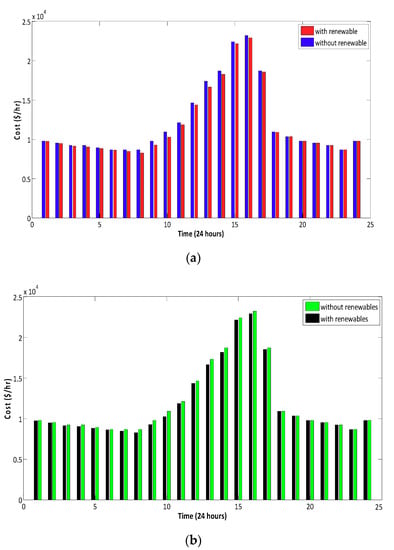
Figure 4.
Cost offered by (a) BA and (b) dBA without and with considering renewables.
4.1.3. Characteristics Offered by BA and dBA
Figure 5, Figure 6, Figure 7, Figure 8 and Figure 9 show the various characteristics of the BA and dBA against test case 1. Figure 5 and Figure 6 show the position of bats for the BA and dBA, respectively. As shown, bats start from random locations (initial solutions) and converge to the best solution after 1000 iterations. However, in the case of dBA, the bats are much better optimized. Figure 7a shows that fitness offered by the BA decreases quickly, which increases the risk of trapping the optimal solution in the local optimum. However, fitness gradually decreases as the iterations progress in the case of dBA. It has a better chance of moving closer to the global optimum. Figure 7b shows the magnified view of the cost convergence curve. Figure 8 shows the pulse rate of the best bat which depicts the decrease of pulse rate as the bat finds its prey. Figure 9 shows the best bat’s loudness, which depicts the increase of loudness as the bat finds its prey.
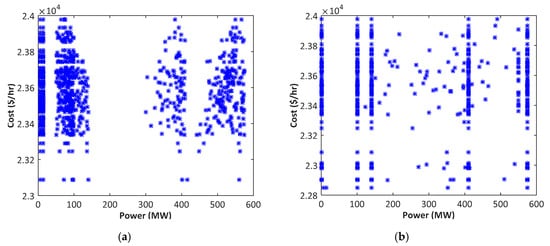
Figure 5.
Bats positions in the BA (a) at the start and (b) after 1000 iterations (seven-unit system with renewables).
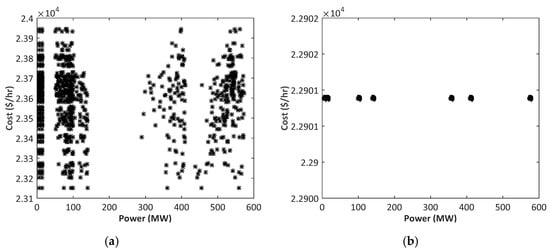
Figure 6.
Bats positions in the dBA (a) before and (b) after 1000 iterations (seven-unit system with renewables).
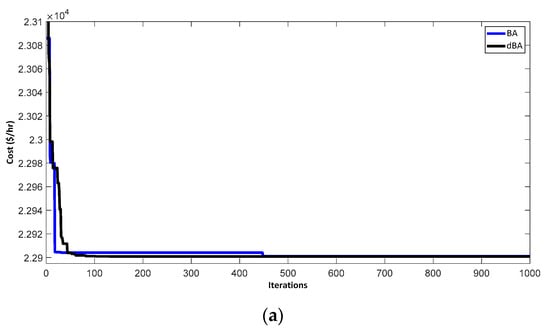
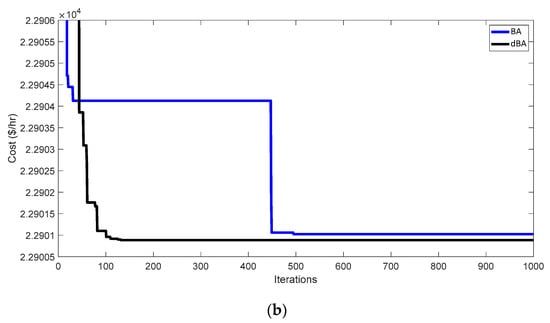
Figure 7.
Convergence curve: (a) The cost convergence curve by the BA and dBA (seven-unit system with renewables); (b) Magnitude view.
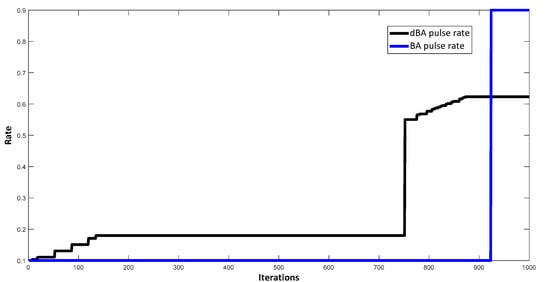
Figure 8.
The pulse rate of the best bat of the BA and dBA.
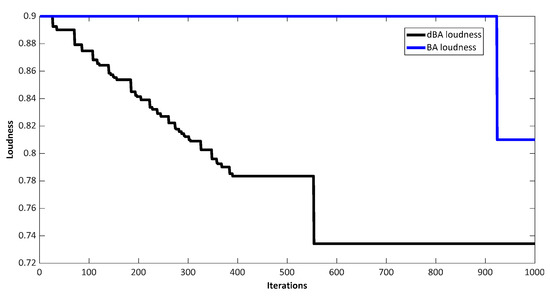
Figure 9.
The loudness of the best bat of the BA and dBA.
4.1.4. Comparison of dBA, BA, PSO, and GA
To further justify the effectiveness of the dBA over BA and other metaheuristic techniques like PSO and GA, a test case of 1800 MW was taken with 100 population and 1000 iterations. Table 5 and Table 6 show the results regarding cost without and with renewables, respectively. It can be seen that the dBA is better when compared to BA, which in turn dominates PSO and GA. Figure 10 shows the convergence graph without renewables, whereas Figure 11 shows the convergence with renewables.

Table 5.
Cost comparison for 1800 MW demand without renewables.

Table 6.
Cost comparison for 1800 MW demand with renewables.
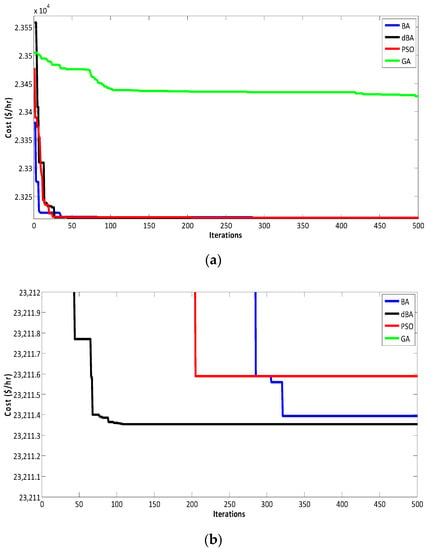
Figure 10.
Convergence curve: (a) Convergence graphs without renewables; (b) Magnified view.

Figure 11.
Convergence curve: (a) Convergence graphs with renewables; (b) Magnified view.
4.2. Case 2: A 15 Thermal Unit System
4.2.1. Data
The data for a 15-unit system is taken from [12], whereas the solar and wind forecasting data is taken from [43]. Table 7 shows the cost coefficients and the minimum and maximum power limits of all 15 thermal units. Table 8 shows the demand forecasting taken into consideration for this case.

Table 7.
15-unit system cost coefficients with lower and upper power limits.

Table 8.
Demand forecasting over 24 h.
4.2.2. Cost Offered by the BA and dBA
In the first scenario where renewables are not taken, both the BA and dBA are applied to a 15-thermal unit system for a 24 h period, and the result is shown in Table 9 and Table 10, respectively. The bat population and iterations are taken as 100 and 1000, respectively. It can be seen that the dBA gives better fitness when compared to the BA. Similarly, in the second scenario where renewables are taken, both BA and dBA were applied to 15 thermal units with renewables (one solar and one wind farm) added for 24 h, and the results are shown in Table 11 and Table 12, respectively. For this scenario, the dBA outperforms the BA in terms of (cost) fitness. The dBA offers not only a minimum cost per day but also a minimum hourly cost. The dBA is found to be more successful in optimizing the total operating cost per day than the BA with or without renewables.

Table 9.
The BA on a 15-unit system without renewables.

Table 10.
The dBA on a 15-unit system without renewables.

Table 11.
The BA on a 15-unit system with renewables.

Table 12.
The dBA on a 15-unit system with renewables.
From the above results, it can be seen that the incorporation of solar and wind farms into the 15-unit thermal system saves 4458 $/day in the case of the BA and approximately 4215 $/day in the case of the dBA. Figure 12 shows this difference clearly.
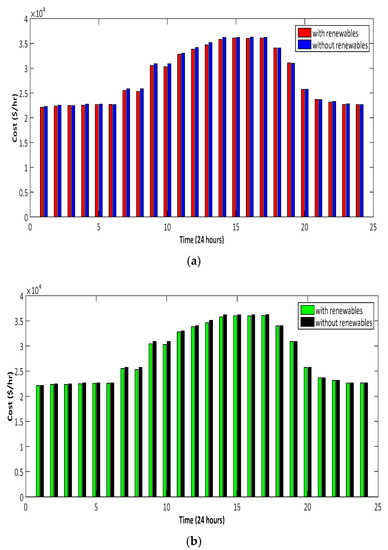
Figure 12.
Cost offered by the (a) BA and (b) dBA without and with considering renewables.
4.2.3. Characteristics Offered by BA and dBA
Figure 13, Figure 14, Figure 15, Figure 16 and Figure 17 show different convergence characteristics of the BA and dBA for selected test Case 2. The bat population was selected as 100, and total iterations were taken at 1000. Figure 13 and Figure 14 show the position of bats of the BA and dBA, respectively at the start and after 1000 iterations. As observed from simulation results, bats start from a random location and converge to the best solution after 1000 iterations. It can also be seen that almost all the bats moved towards the best solution, showing that the solution is much closer to a global solution. However, in the case of the dBA, the bats are much better optimized. Figure 15a shows that the BA’s fitness decreases very quickly, which increases the risk of capturing the local optimum solution. The fitness gradually decreases as the iteration increases. It gives a better chance of moving the solution closer to the global best position. Figure 15b shows the magnified view of the cost convergence curve. Figure 16 shows the pulse rate of the best bat, which depicts the decrease of pulse rate as the bat finds its prey. Figure 17 shows the best bat’s loudness, which depicts the increase of loudness as the bat finds its prey.
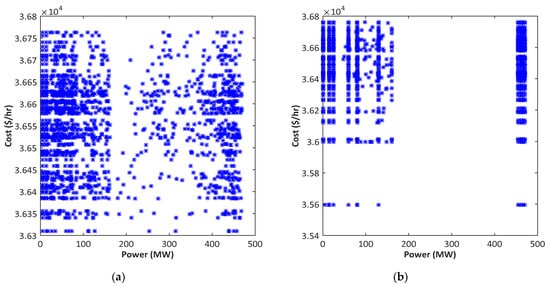
Figure 13.
Bats positions in the BA (a) at the start and (b) after 1000 iterations (15-unit system with renewables).
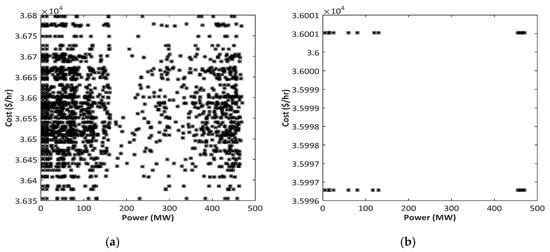
Figure 14.
Bats positions in the dBA (a) before and (b) after 1000 iterations (15-unit system with renewables).
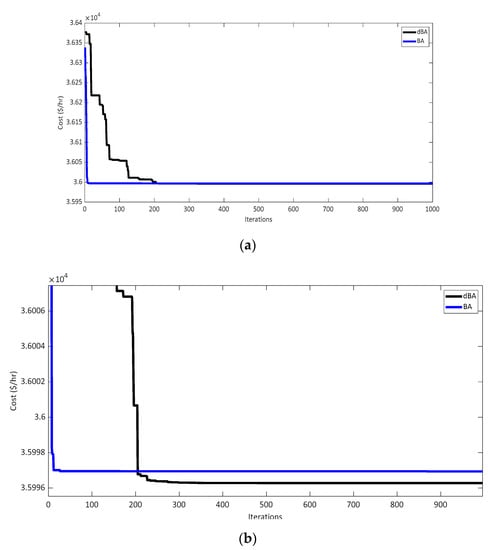
Figure 15.
Convergence curve: (a) The cost convergence curve by the BA and dBA (15-unit system with renewables); (b) Magnified view.
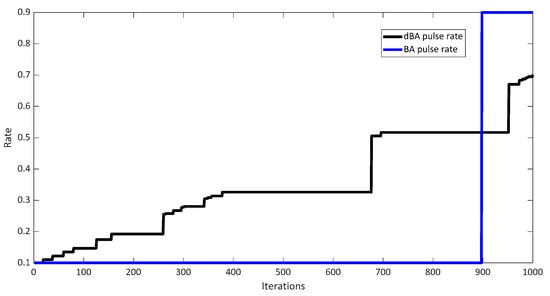
Figure 16.
The pulse rate of the best bat of the BA and dBA.
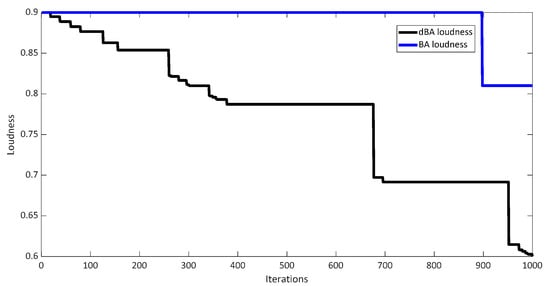
Figure 17.
The loudness of the best bat of the BA and dBA.
4.2.4. Comparison of dBA, BA, PSO, and GA
Simulation results reveal that the variant dBA shows promising results in terms of better quality and convergence characteristics without being trapped in local optima compared to the conventional BA. To further validate the applicability of dBA, a test case of 3000 MW demand was taken and solved with population and iterations of 100 and 1000, respectively, using BA, dBA, PSO, and GA. Table 13 shows the result without renewables and Table 14 with renewables. It can be seen that the dBA tends to give better fitness than the BA, which in turn gives better results than that of the PSO and GA. Figure 18 and Figure 19 depict the achievements regarding convergence characteristics.

Table 13.
Cost comparison for 3000 MW demand without renewables.

Table 14.
Cost comparison for 3000 MW demand with renewables.
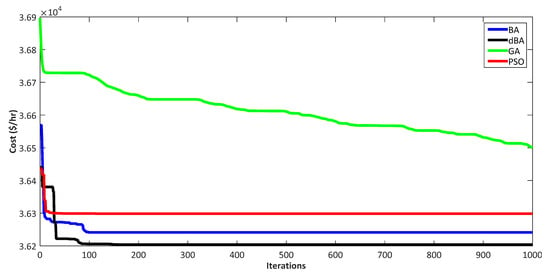
Figure 18.
Convergence graphs for 3000 MW demand without renewables.
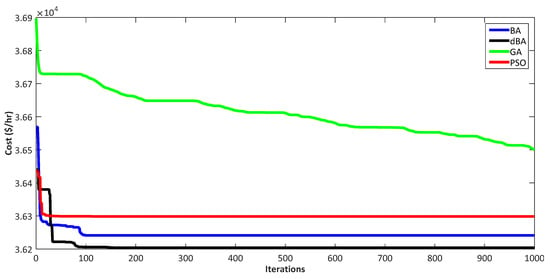
Figure 19.
Convergence graphs for 3000 MW demand with renewables.
For all the scenarios considered in test cases, the dBA always performed better when compared to the BA and other metaheuristics such as the GA and PSO. This justifies the applicability and potency of dBA to renewables-incorporated ELD problems.
4.3. Case 3: 6 Thermal Units with Valve Point Effect
4.3.1. Data
An IEEE 30 bus system which consists of six thermal units running from fossil fuels with a valve point effect, is considered. The cost coefficients with minimum and maximum power generation limits are shown in Table 15 [26]. In Table 16, a 24 h load forecasting is selected as a load demand which is to be met. It can be seen that the maximum power demand at 1600 h is 1350 MW. In this case, .

Table 15.
Cost coefficients of seven thermal units with lower and upper power limits.

Table 16.
Demand forecasting over 24 h.
The data used for RESs are mentioned where the renewables-incorporated ELD problem is discussed in the following sections/subsections.
4.3.2. Cost Offered by the BA and dBA
Table 17 shows the simulation results of the aBA and dBA in terms of operating cost for a 24 h period. It can be seen that the dBA comparatively gives less operating cost, i.e., 262,196.7 $/day than that of the BA, which gives 263,734.7 $/day. Even for most of the load demand for each hour, the dBA ensures a lower cost when compared to the BA. This ensures that the dBA displays a better global optimum solution with regards to the conventional BA. In the second scenario, a six-unit thermal system was added with one wind and one solar PV farm. Both BA and dBA were applied to ELD-incorporating renewables. Table 18 shows the result of the BA and dBA over a 24 h time period. It is clear from the results that the dBA gives better fitness results than the BA. The dBA is found to be more successful in reducing the total cost per day than the BA with or without renewables.

Table 17.
The BA and dBA on a six-thermal unit system without renewables.

Table 18.
The BA and dBA on a six-thermal unit system with renewables (wind and solar).
4.3.3. Comparison with Other Algorithms
To further justify the effectiveness of the dBA over the BA, PSO, GA, and enhanced bat algorithm (EBA) (another variant of BA), a test case of 1263 MW was taken. A population size of 50 and 200 iterations were taken for this case for all algorithms. The dBA was compared with the EBA, BA, PSO, and GA for an ELD problem without and with renewables. In [26], the EBA is already applied to the same 6-unit thermal system, taking the valve point effect. The parameters used for the EBA are the following: fmin = 0, fmax = 2, r0 = 0.5, A0 = 0.9, learning factor (ῤinit) = 0.65, and modulation Index (n) = 3. Table 19 shows a comparison of all mentioned techniques for the demand of 1263 MW. It can be seen that the dBA gives the lowest value when compared to other metaheuristic techniques. Table 20 shows a comparison of the same techniques without the EBA for a demand of 1263 MW. It can be seen that the dBA still gives the lowest value when compared to other metaheuristic techniques. Figure 20 shows the convergence graph without renewables, whereas Figure 21 shows the convergence with renewables, both for a load demand of 1263 MW.

Table 19.
Comparison of the dBA, enhanced bat algorithm (EBA), BA, PSO, and GA without renewables.

Table 20.
Comparison of the dBA, BA, PSO, and GA with renewables.
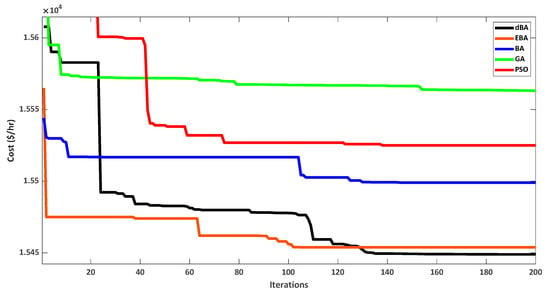
Figure 20.
Cost convergence graph with valve point effect without renewables.
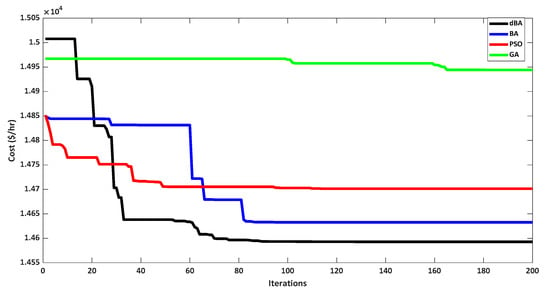
Figure 21.
Cost convergence graph with the valve point effect and renewables.
4.4. Case 4
To further compare the effectiveness of the dBA with other metaheuristic techniques, in this case study, a 150 kV power system located in East Java, Indonesia, consisting of 10 units, is considered. Cost coefficients of the units with lower and upper power bounds, taken from [51], are summarized in Table 21. The total system demand without the transmission losses is 616 MW. Population size and iterations are kept the same for all the techniques to compare the results on one scale.

Table 21.
A 10-unit thermal system cost coefficients with lower and upper power limits.
A comparison of the results offered by the dBA and other algorithms such as the BA, GA, PSO, and modified inertial weight-based PSO (MIW-PSO) is presented in Table 22. The dBA offers a low cost, i.e., 95,633 $/h when compared to all other mentioned techniques, thus validating the workability of the dBA. This low cost is also depicted in the convergence characteristics drawn for the dBA and MIWPSO, as shown in Figure 22. For the comparison purpose, the convergence characteristics are drawn for 15 iterations.

Table 22.
Comparison of dBA, BA, GA, PSO, and modified inertial weight-based PSO (MIW-SPO).
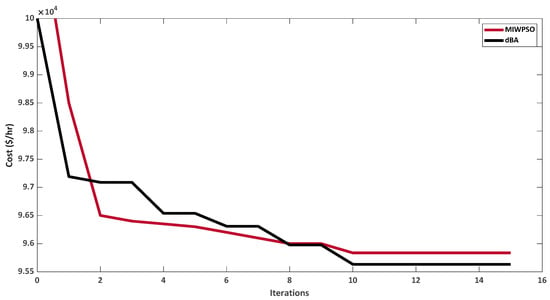
Figure 22.
Cost convergence graph of the dBA and MIWPSO in a 10-unit system case.
From the inspection of the convergence characteristics of all the considered case studies, we observed that at the initial stage, the dBA almost converges slowly compared to other algorithms due to a rigorous exploration process to ensure effective search space exploration. However, as the algorithm progresses, the exploitation dominates exploration to speed up the convergence toward global optimum compared to other algorithms. The dBA boosts its exploration and exploitation capabilities due to the introduction of directional echolocation to the structure of BA, the inclusion of a scale factor in the local search step to make the movement random, thus avoiding a local convergence, the acceptance of new solutions based on a random value to ameliorate the solution quality, and monotonically increasing and decreasing pulse rate and loudness, respectively, to enhance diversity. In this way, the dBA offers promising convergence characteristics compared to other algorithms, giving a low total fuel cost. We also noticed that the algorithm performs better as the problems’ dimensions increase because of its capability to promote diversity and avoid the local optima.
5. Conclusions
In this paper, the modified directional bat algorithm (dBA), which is a useful variant of nature-inspired (BA), was utilized to solve the ELD problem with and without the optimal integration of RESs such as solar and wind. The dominance of this metaheuristic technique was highlighted by comparing the performance of the dBA with BA and other prominent metaheuristics techniques like GA and PSO. Moreover, to show the superiority of the dBA, it was also compared with the variants of PSO and BA such as MIWPSO and EBA. Different test cases were considered to analyze and compare the performance of the dBA. From the simulation results, it could be seen that by incorporating renewables in the thermal unit system, the operating cost of the system decreased significantly. Moreover, with the help of directional echolocation, the dBA outperformed all other algorithms with comparatively fast convergence. It also reduced the probability of a premature convergence problem due to the elitism mechanism. In addition, the valve point effect was also considered to test the algorithm with a more practical system. In future, this improved variant of the BA could be applied to even more realistic ELD problems taking more practical constraints such as prohibited operating zones, multiple fuel options, and transmission losses along with other renewables.
Author Contributions
Conceptualization, F.T. and G.A.; Data curation, S.A.; Formal analysis, G.A. and M.R.H.; Funding acquisition, S.A.; Investigation, G.A.; Methodology, F.T.; Project administration, G.A.; Resources, M.R.H.; Software, A.Q.; Visualization, S.A.; Writing—original draft, F.T.; Writing—review & editing, A.Q. All authors have read and agreed to the published version of the manuscript.
Funding
This research is financially supported by the Deanship of Scientific Research at King Khalid University under research grant number (R.G.P2/100/41).
Acknowledgments
The authors extend their appreciation to the Deanship of Scientific Research, King Khalid University under research grant number (R.G.P2/100/41). The authors would like to express their gratitude to The University of Lahore for the administrative and technical support.
Conflicts of Interest
The authors declare no conflict of interest.
References
- Niknam, T.; Azizipanah-Abarghooee, R.; Aghaei, J. A new modified teaching-learning algorithm for reserve constrained dynamic economic dispatch. IEEE Trans. Power Syst. 2012, 28, 749–763. [Google Scholar] [CrossRef]
- Park, J.-B.; Lee, K.-S.; Shin, J.-R. A particle swarm optimization for economic dispatch with nonsmooth cost functions. IEEE Trans. Power Syst. 2005, 20, 34–42. [Google Scholar] [CrossRef]
- Puri, V.; Chauhan, Y.K. A solution to economic dispatch problem using augmented Lagrangian particle swarm optimization. Int. J. Emerg. Technol. Adv. Eng. ISSN 2012, 2250–2459. [Google Scholar]
- Park, J.-B.; Jeong, Y.-W.; Shin, J.-R.; Lee, K.Y. An improved particle swarm optimization for nonconvex economic dispatch problems. IEEE Trans. Power Syst. 2009, 25, 156–166. [Google Scholar] [CrossRef]
- Yang, Y.; Wei, B.; Liu, H.; Zhang, Y.; Zhao, J.; Manla, E. Chaos firefly algorithm with self-adaptation mutation mechanism for solving large-scale economic dispatch with valve-point effects and multiple fuel options. IEEE Access 2018, 6, 45907–45922. [Google Scholar] [CrossRef]
- Vo, D.N.; Schegner, P.; Ongsakul, W. Cuckoo search algorithm for non-convex economic dispatch. IET Gener. Transm. Distrib. 2013, 7, 645–654. [Google Scholar] [CrossRef]
- Niknam, T.; Golestaneh, F. Enhanced bee swarm optimization algorithm for dynamic economic dispatch. IEEE Syst. J. 2013, 7, 754–762. [Google Scholar] [CrossRef]
- Zaman, M.F.; Elsayed, S.M.; Ray, T.; Sarker, R.A. Evolutionary algorithms for dynamic economic dispatch problems. IEEE Trans. Power Syst. 2016, 31, 1486–1495. [Google Scholar] [CrossRef]
- Dekhici, L.; Borne, P.; Khaled, B. Firefly algorithm for economic power dispatching with pollutants emission. Inform. Econ. 2012, 16, 45–57. [Google Scholar]
- Zhao, J.; Liu, S.; Zhou, M.; Guo, X.; Qi, L. Modified cuckoo search algorithm to solve economic power dispatch optimization problems. IEEE/CAA J. Autom. Sin. 2018, 5, 794–806. [Google Scholar] [CrossRef]
- Ma, X.; Liu, Y. Particle swarm optimization to solving economic load dispatch with spinning reserve. In Proceedings of the 2010 International Conference on Computer Design and Applications, Qinhuangdao, China, 25–27 June 2010; Volume 4, pp. V4–214–V4–217. [Google Scholar]
- Gaing, Z.-L. Particle swarm optimization to solving the economic dispatch considering the generator constraints. IEEE Trans. Power Syst. 2003, 18, 1187–1195. [Google Scholar] [CrossRef]
- Meng, K.; Wang, H.-G.; Dong, Z.; Wong, K.P. Quantum-inspired particle swarm optimization for valve-point economic load dispatch. IEEE Trans. Power Syst. 2009, 25, 215–222. [Google Scholar] [CrossRef]
- Abdullah, N.R.H.; Ghazali, N.; Ibrahim, N.; Solleh, N.F.; Samad, R.; Mustafa, M.; Pebrianti, D. Solving economic dispatch (ED) problem using artificial immune system, evolutionary programming and particle swarm optimization. ARPN J. Eng. Appl. Sci. 2006, 11, 6663–6667. [Google Scholar]
- Khamsawang, S.; Jiriwibhakorn, S. Solving the economic dispatch problem using novel particle swarm optimization. World Acad. Sci. Eng. Technol.-Int. J. Electr. Comput. Energ. Electron. Commun. Eng. 2009, 3, 529–534. [Google Scholar]
- Abbas, G.; Gu, J.; Farooq, U.; Asad, M.U.; El-Hawary, M. Solution of an economic dispatch problem through particle swarm optimization: A detailed survey-Part I. IEEE Access 2017, 5, 15105–15141. [Google Scholar] [CrossRef]
- Abbas, G.; Gu, J.; Farooq, U.; Raza, A.; Asad, M.U.; El-Hawary, M.E. Solution of an economic dispatch problem through particle swarm optimization: A detailed survey; Part II. IEEE Access 2017, 5, 24426–24445. [Google Scholar] [CrossRef]
- Trivedi, I.N.; Jangir, P.; Bhoye, M.; Jangir, N. An economic load dispatch and multiple environmental dispatch problem solution with microgrids using interior search algorithm. Neural Comput. Appl. 2018, 30, 2173–2189. [Google Scholar] [CrossRef]
- Biswal, S.; Barisal, A.K.; Behera, A.; Prakash, T. Optimal power dispatch using BAT algorithm. In Proceedings of the 2013 International Conference on Energy Efficient Technologies for Sustainability, Nagercoil, India, 10–12 April 2013; pp. 1018–1023. [Google Scholar]
- Sakthivel, S.; Natarajan, R.; Gurusamy, P. Application of bat optimization algorithm for economic load dispatch considering valve point effects. Int. J. Comput. Appl. 2013, 67, 35–39. [Google Scholar] [CrossRef][Green Version]
- Nguyen, T.T.; Ho, S.D. Bat algorithm for economic emission load dispatch problem. Int. J. Adv. Sci. Technol. 2016, 86, 51–60. [Google Scholar] [CrossRef]
- Gherbi, Y.A.; Bouzeboudja, H.; Lakdja, F. Economic dispatch problem using bat algorithm. Leonardo J. Sci. 2014, 24, 75–84. [Google Scholar]
- Latif, A.; Palensky, P. Economic dispatch using modified bat algorithm. Algorithms 2014, 7, 328–338. [Google Scholar] [CrossRef]
- Niknam, T.; Azizipanah-Abarghooee, R.; Zare, M.; Bahmanifirouzi, B. Reserve constrained dynamic environmental/economic dispatch: A new multiobjective self-adaptive learning bat algorithm. IEEE Syst. J. 2013, 7, 763–776. [Google Scholar] [CrossRef]
- Adarsh, B.; Raghunathan, T.; Jayabarathi, T.; Yang, X.-S. Economic dispatch using chaotic bat algorithm. Energy 2016, 96, 666–675. [Google Scholar] [CrossRef]
- Pradhan, G.; Dewangan, P.D. Solving optimal load dispatch problem using enhanced BAT optimization algorithm. In Proceedings of the 2017 Innovations in Power and Advanced Computing Technologies (i-PACT), Vellore, India, 21–22 April 2017; pp. 1–6. [Google Scholar]
- Fister, I.; Yang, X.-S.; Fong, S.; Zhuang, Y. Bat algorithm: Recent advances. In Proceedings of the 2014 IEEE 15th International Symposium on Computational Intelligence and Informatics (CINTI), Budapest, Hungary, 19–21 November 2014; pp. 163–167. [Google Scholar]
- Gautham, S.; Rajamohan, J. Economic load dispatch using novel bat algorithm. In Proceedings of the 2016 IEEE 1st International Conference on Power Electronics, Intelligent Control and Energy Systems (ICPEICES), Dehli, India, 4–6 July 2016; pp. 1–4. [Google Scholar]
- Liang, H.; Liu, Y.; Shen, Y.; Li, F.; Man, Y. A hybrid bat algorithm for economic dispatch with random wind power. IEEE Trans. Power Syst. 2018, 33, 5052–5061. [Google Scholar] [CrossRef]
- Osório, G.; Lujano-Rojas, J.; Matias, J.C.D.O.; Catalão, J.P. A probabilistic approach to solve the economic dispatch problem with intermittent renewable energy sources. Energy 2015, 82, 949–959. [Google Scholar] [CrossRef]
- Nikmehr, N.; Ravadanegh, S.N. A study on optimal power sharing in interconnected microgrids under uncertainty. Int. Trans. Electr. Energy Syst. 2015, 26, 208–232. [Google Scholar] [CrossRef]
- Khan, N.A.; Awan, A.B.; Mahmood, A.; Razzaq, S.; Zafar, A.; Sidhu, G.A.S. Combined emission economic dispatch of power system including solar photo voltaic generation. Energy Convers. Manag. 2015, 92, 82–91. [Google Scholar] [CrossRef]
- Farhat, I.; El-Hawary, M. Dynamic adaptive bacterial foraging algorithm for optimum economic dispatch with valve-point effects and wind power. IET Gener. Transm. Distrib. 2010, 4, 989. [Google Scholar] [CrossRef]
- Li, Z.; Wu, W.; Zhang, B.; Sun, H.; Yang, Y. Dynamic economic dispatch using Lagrangian relaxation with multiplier updates based on a quasi-newton method. IEEE Trans. Power Syst. 2013, 28, 4516–4527. [Google Scholar] [CrossRef]
- Han, L.; Romero, C.E.; Wang, X.; Shi, L. Economic dispatch considering the wind power forecast error. IET Gener. Transm. Distrib. 2018, 12, 2861–2870. [Google Scholar] [CrossRef]
- Brini, S.; Abdallah, H.H.; Ouali, A. Economic dispatch for power system included wind and solar thermal energy. Leonardo J. Sci. 2009, 14, 204–220. [Google Scholar]
- Warsono; King, D.J.; Ozveren, C.S.; Bradley, D. Economic load dispatch optimization of renewable energy in power system using genetic algorithm. In Proceedings of the 2007 IEEE Lausanne Power Tech, Lausanne, Switzerland, 1–5 July 2007; pp. 2174–2179. [Google Scholar]
- Roy, S. Inclusion of short duration wind variations in economic load dispatch. IEEE Trans. Sustain. Energy 2012, 3, 265–273. [Google Scholar] [CrossRef]
- Jadoun, V.K.; Pandey, V.C.; Gupta, N.; Niazi, K.R.; Swarnkar, A. Integration of renewable energy sources in dynamic economic load dispatch problem using an improved fireworks algorithm. IET Renew. Power Gener. 2018, 12, 1004–1011. [Google Scholar] [CrossRef]
- Tang, C.; Xu, J.; Tan, Y.; Sun, Y.; Zhang, B. Lagrangian relaxation with incremental proximal method for economic dispatch with large numbers of wind power scenarios. IEEE Trans. Power Syst. 2019, 34, 2685–2695. [Google Scholar] [CrossRef]
- Kheshti, M.; Kang, X.; Li, J.; Regulski, P.; Terzija, V. Lightning flash algorithm for solving non-convex combined emission economic dispatch with generator constraints. IET Gener. Transm. Distrib. 2018, 12, 104–116. [Google Scholar] [CrossRef]
- Nivedha, R.R.; Singh, J.G.; Ongsakul, W. PSO based economic dispatch of a hybrid microgrid system. In Proceedings of the 2018 International Conference on Power, Signals, Control and Computation (EPSCICON), Thrissur, India, 6–10 January 2018; pp. 1–5. [Google Scholar]
- Augustine, N.; Suresh, S.; Moghe, P.; Sheikh, K. Economic dispatch for a microgrid considering renewable energy cost functions. In Proceedings of the 2012 IEEE PES Innovative Smart Grid Technologies (ISGT), Washington, DC, USA, 16–20 January 2020; pp. 1–7. [Google Scholar]
- Agrawal, S.P.; Porate, K.B. Economic dispatch of thermal units with the impact of wind power plant. In Proceedings of the 2010 3rd International Conference on Emerging Trends in Engineering and Technology, Goa, India, 19–21 November 2020; pp. 48–53. [Google Scholar]
- Jose, J.T. Economic load dispatch including wind power using Bat Algorithm. In Proceedings of the 2014 International Conference on Advances in Electrical Engineering (ICAEE), Singapore, Singapore, 19 February 2014; pp. 1–4. [Google Scholar]
- Ellahi, M.; Abbas, G.; Khan, I.; Koola, P.M.; Nasir, M.; Raza, A.; Farooq, U. Recent approaches of forecasting and optimal economic dispatch to overcome intermittency of wind and Photovoltaic (PV) systems: A review. Energies 2019, 12, 4392. [Google Scholar] [CrossRef]
- Yang, X.-S. A new metaheuristic bat-inspired algorithm. In Nature Inspired Cooperative Strategies for Optimization (NICSO 2010); Springer: Berlin/Heidelberg, Germany, 2010; pp. 65–74. [Google Scholar]
- Chakri, A.; Khelif, R.; Benouaret, M.; Yang, X.-S. New directional bat algorithm for continuous optimization problems. Expert Syst. Appl. 2017, 69, 159–175. [Google Scholar] [CrossRef]
- Chakri, A.; Ragueb, H.; Yang, X.-S. Bat algorithm and directional bat algorithm with case studies. In Nature-Inspired Algorithms and Applied Optimization; Springer: Cham, Switzerland, 2018; pp. 189–216. [Google Scholar]
- Rahmat, N.A.; Aziz, N.F.A.; Mansor, M.H.; Musirin, I. Optimizing economic load dispatch with renewable energy sources via differential evolution immunized ant colony optimization technique. Int. J. Adv. Sci. Eng. Inf. Technol. 2017, 7, 2012–2017. [Google Scholar] [CrossRef]
- Lee, C.-Y.; Tuegeh, M. An optimal solution for smooth and non-smooth cost functions-based economic dispatch problem. Energies 2020, 13, 3721. [Google Scholar] [CrossRef]
Publisher’s Note: MDPI stays neutral with regard to jurisdictional claims in published maps and institutional affiliations. |
© 2020 by the authors. Licensee MDPI, Basel, Switzerland. This article is an open access article distributed under the terms and conditions of the Creative Commons Attribution (CC BY) license (http://creativecommons.org/licenses/by/4.0/).